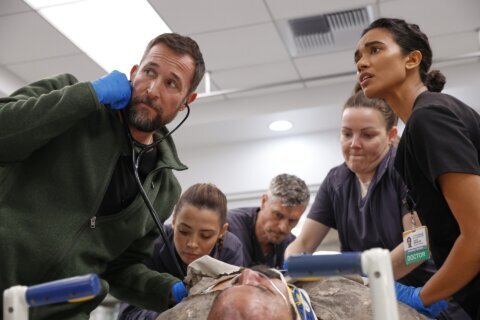“I like boys, I like loud music, I like gyrating, I’m 13! Deal with it!”
So declares the main character in Disney and Pixar’s new animated film “Turning Red,” a coming-of-age fantasy that serves as an allegory for puberty this weekend on Disney+.
Hats off to the filmmakers for having the guts to wade into this territory, creating one of the most original, refreshing and personal stories that Disney and Pixar have told in years.
Set in Toronto circa 2002, the story follows 13-year-old Chinese-Canadian student Mei Lee (Rosalie Chiang), who turns into a giant red panda whenever she gets too excited over boys, homework or living with her strict mother, Ming (Sandra Oh). Mei must learn to harness her emotions in time to join her friends at a concert by her favorite boy band.
Twitter is littered with male movie critics whose faces are “turning red” at the idea of a Disney movie dealing with (gasp) menstruation, but this says more about critics’ maturity levels than the filmmakers. It shouldn’t be hard to empathize with the concept of puberty, which we’ve all gone through, and see it from a woman’s perspective. Period. Full stop.
If you’re a female viewer, you probably remember fighting with your mom as a teenager. If you’re a male viewer, you may recall your teenage sister fighting with your mom. Hell, even teenage boys fight with their parents during puberty as their testosterone rages. “People still talk about Pandapocalypse 2002,” Mei says. “Mom and I just call it growing pains.”
These growing pains reveal deeper family themes of mothers and daughters forgiving each other for outbursts during these hormonal times. Daughters feel the pressure of straight A’s, while mothers just want to prepare them for a competitive world. We even see how the grandmother gives the mother baggage from when she was a teenager. It’s all a cycle.
Could this “cycle” allegory be more subtle? Sure, but the importance of tackling the issue outweighs the nuance. When Mei gets her first red scare, she’s mortified, hiding behind the shower curtain as her mom grabs a box of tampons, unaware that she’s actually turning into a giant red panda. It’s a clever way to “go there” without literally showing it on screen.
Besides, this mother is far more supportive than shouting, “They’re all gonna laugh at you!” like the underrated horror masterpiece “Carrie” (1976). Stephen King actually threw his rough draft in the trash, only for his wife to retrieve it and insist that he finish It, becoming his first published novel. See? Women know what other women want to read and watch.
As groundbreaking as it was in 1976, “Carrie” still remained an interpretation of puberty by two men — King dreamed the idea of a prom queen getting doused in blood, while director Brian De Palma delivered an impressive Figure-8 tracking shot — so it’s refreshing that “Turning Red” finally provides a woman’s perspective telling her own personal journey.
Writer/director Domee Shi bases Mei on her own experiences growing up in Toronto, just like Greta Gerwig did with Sacramento in “Lady Bird” (2017). Shi knows the city well, painting Toronto as a thriving hub of diversity, not only within Mei’s close circle of friends, but also populating the town with background characters that just happen to wear hijabs.
In doing so, Shi completes a heroic journey from being a storyboard artist on “Inside Out” (2015) to becoming the first woman to direct a Pixar short with the Oscar-winning “Bao” (2018) to finally becoming the first woman ever to direct a Pixar film solo in “Turning Red” (2022). May her success story inspire little girls (and boys) of all colors to make movies.
From “Moana” (2016) to “Coco” (2017), “Soul” (2020) to “Encanto” (2021), white critics and viewers are increasingly being asked to relate to other cultures. Good! Welcome to what people of color have been asked to do their entire lives watching Disney movies — or women for that matter, routinely asked to view countless classics through a “male gaze.”
Roger Ebert once called cinema the “ultimate empathy machine” for its unique ability to place us in other people’s shoes. When the lights come up and we exit the movie theater, we magically emerge changed and enlightened, having spent two hours vicariously as Chiron in “Moonlight” (2016), Cleo in “Roma” (2018) or Mei in “Turning Red” (2022).
I personally found it easy to relate to these characters, in part because of the time period in which the animated story takes place. Having graduated high school in 2003, I smiled nostalgically at the film’s setting, providing all of the era’s touchstones, be it feeding your digital pet Tamagotchi, burning CD mixtapes or jamming to boy bands on the radio.
Which brings us to the film’s most hilarious touch, the fictional boy band 4*Town, which borrows its name from O-Town and asterisk from *NSYNC, but also stands in for every other group from The Backstreet Boys to 98 Degrees, One Direction to the Jonas Brothers. Note that the songs are fittingly written by Billie Eilish and her brother Finneas O’Connell.
Their stadium tour concert is the perfect place for the climax, as Mei’s authentic teen desires collide with her supernatural curse, causing reality and fantasy to explode in a grand finale that’s one of the best in recent memory. The Stay Puft Marshmallow Man in “Ghostbusters” (1984) has nothing on a giant red panda stomping young concertgoers.
As Mei dances to 4*Town in a post-credits scene, you’ll wonder: will a member of 4*Town break off for a stellar solo career to bring sexy back like Justin Timberlake? Will they get a reality show like Nick Lachey? Or will the foursome become a trio like Boyz II Men?
Either way, there’s a new animated kid on the block, thy name is Girlz II Women.









